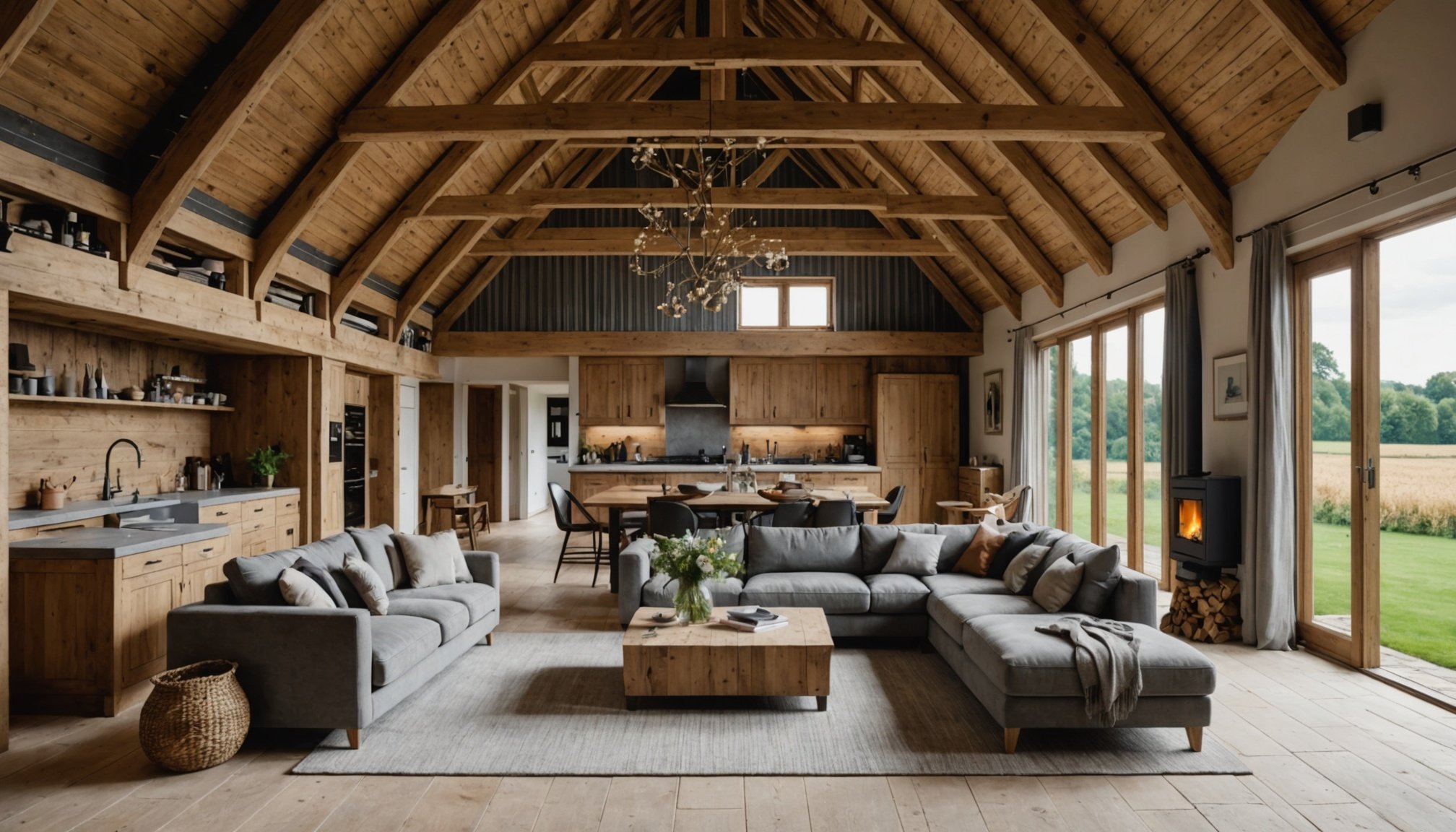Ultimate Guide to Converting a UK Barn into a Chic and Comfortable Home Retreat
Converting a barn into a home is a dream shared by many, especially those who cherish the unique charm and character of rural settings. If you’re considering embarking on this exciting project, here’s a comprehensive guide to help you navigate the process, from planning and design to the final touches of your dream home.
Understanding the Basics of Barn Conversions
Before diving into the details, it’s essential to understand the context and regulations surrounding barn conversions in the UK.
In parallel : Designing the ideal outdoor kitchen for uk homes: how to incorporate seasonal weather into your space
What is a Class Q Conversion?
A Class Q conversion is a permitted development right that allows certain agricultural buildings, such as barns, to be transformed into residential properties without the need for a comprehensive planning application. This is outlined in the General Permitted Development Order (GPDO) and is a key factor in making barn conversions more accessible[2].
Eligibility and Restrictions
Not all barns are eligible for Class Q conversions. For instance, listed buildings, sites of scientific interest, and world heritage sites are excluded. Additionally, the building must be structurally strong enough to convert, and any new development must comply with specific criteria such as not extending the footprint of the building and ensuring the design is suitable for residential use[2].
Topic to read : Brilliant lighting solutions to elevate your uk loft with stunning exposed brick walls
Planning and Permission: Navigating the Red Tape
Securing the necessary permissions is a critical step in any barn conversion project.
Class Q Approval Process
While Class Q conversions do not require full planning permission, you still need to submit an application to your local planning authority to outline the proposed development. This pre-approval process evaluates several factors, including:
- Impact on Traffic and Roads: The effect of the conversion on local traffic and road access.
- Risk of Flooding: Ensuring the property is not in a high-risk flooding area unless adequate flood prevention measures are in place.
- Design and Look: The design and appearance of the converted building must be suitable for its new use as a residential dwelling.
- Noise & Contamination Concerns: Assessing potential noise disturbances and ensuring the property is free from contaminants[2].
Recent Updates and Changes
As of April 30, 2024, Class Q permitted development has been updated, allowing for more flexibility. The maximum number of new dwellings has increased from five to ten, and the allowable space for conversion has expanded to 1,000 square meters. However, the maximum size for each dwelling has been reduced to 150 square meters[2].
Designing Your Dream Home: From Layout to Finishing Touches
The design phase is where your vision for the perfect home begins to take shape.
Understanding Your Lifestyle Needs
The first step in designing the layout is to understand how you will use the space. Consider what essential areas you need, such as a large open-plan kitchen-diner for entertaining or private areas for bedrooms and a home office. By prioritizing these needs, you can create a design that supports your day-to-day activities while making the most of the barn’s unique features[3].
Creating Zones within an Open Floor Plan
Barns often feature expansive, open interiors that need careful planning to create a functional and comfortable environment. Here are some tips for creating zones within an open floor plan:
- Flexible Room Dividers: Use sliding partitions, movable screens, or modular furniture to transform a single large area into smaller, purpose-driven zones.
- Multi-Purpose Areas: Design spaces that can serve multiple functions, such as a living area that doubles as a home office or playroom.
- Preserving Rustic Features: Maintain original elements like timber beams, exposed brick, and stone walls to retain the barn’s heritage and character[3].
Blending Old with New
Achieving a balance between preserving historic elements and incorporating modern comforts is key to creating a timeless yet practical home.
- Restoring Original Features: Restore intricate wooden joinery, centuries-old stone walls, and other original elements to make them focal points in your design.
- Integrating Modern Design Elements: Incorporate modern touches such as smart home systems, energy-efficient features like insulation and double glazing, and renewable energy sources to ensure your home is both eco-friendly and functional[3].
Practical Considerations: Cost, Structural Integrity, and More
Several practical aspects need careful consideration to ensure your project is successful.
Average Cost of a Barn Conversion
The average cost of a barn conversion in the UK ranges between £100,000 and £300,000, depending on the size and condition of the barn, the location, and the extent of the renovation work required[3].
Structural Integrity
Assessing the structural integrity of the barn is crucial. Here are some key points to consider:
- Structural Survey: Conduct a full structural survey, often referred to as a ‘structural appraisal,’ to ensure the building can support the conversion.
- Necessary Repairs: Make any necessary repairs to the structure before proceeding with the conversion.
- New Structural Elements: For modern barns, new structural elements may be required to make the building habitable, which is now more permissible under updated Class Q guidance[1].
Energy Efficiency and Sustainability
Incorporating energy-efficient features is not only eco-friendly but also cost-effective in the long run. Here are some tips:
- Insulation and Double Glazing: Ensure the building is well-insulated and fitted with double glazing to reduce energy consumption.
- Renewable Energy Sources: Consider installing renewable energy sources such as solar panels or a biomass boiler.
- Reclaimed Wood: Use reclaimed wood for flooring and other elements to add character and reduce the environmental impact of new materials[3].
Overcoming Common Challenges
Barn conversions can come with unique challenges, but with the right approach, these can be overcome.
Transport and Highways Impacts
The conversion must not significantly impact local traffic and road access. Here are some considerations:
- Access Roads: Ensure that the access roads are suitable for the increased traffic.
- Parking: Provide adequate parking facilities to avoid congestion.
Noise and Contamination Concerns
Assess potential noise disturbances and ensure the property is free from contaminants.
- Noise Assessment: Conduct a noise assessment to determine if there are any significant noise disturbances from nearby farming or other activities.
- Contamination Risk: Ensure the property and its land are free from contaminants that could be harmful to residents[2].
Real-Life Examples and Success Stories
Seeing how others have successfully converted barns into homes can be incredibly inspiring.
A Cambridgeshire Couple’s Journey
Clive and Sue, a couple from Cambridgeshire, converted their Victorian stable block and cowshed into a home after changes in planning rules made it possible. They later replaced an old asbestos warehouse with a new house designed to replicate the look of a traditional agricultural building. Their journey highlights the importance of working closely with planners and architectural technologists to achieve the desired outcome[5].: Turning Your Vision into Reality
Converting a barn into a chic and comfortable home retreat is a rewarding but complex process. Here are some final tips to keep in mind:
Stay Informed and Adaptable
- Keep Up with Regulations: Stay updated with the latest regulations and changes in permitted development rights.
- Be Flexible: Be prepared to adapt your design and plans as needed to comply with local planning authorities and overcome any challenges that arise.
Seek Professional Advice
- Consult Experts: Work with architects, structural engineers, and other professionals to ensure your project is well-planned and executed.
- Local Knowledge: Utilize local knowledge and expertise to navigate the planning process and ensure compliance with all relevant building codes and regulations.
Enjoy the Journey
- Celebrate the Process: Remember that converting a barn is a journey that combines creativity, practicality, and respect for history.
- Personal Touches: Incorporate personal touches and unique design elements to make your home truly special.
By following this guide, you’ll be well on your way to creating a wonderful stay in your dream home, blending the rustic charm of a barn with the comforts of modern living.
Table: Key Considerations for Barn Conversions
| Aspect | Description | Key Points |
|---|---|---|
| Planning Permission | Class Q conversion pre-approval | Submit application to local planning authority, evaluate traffic, flooding, design, noise, and contamination concerns[2] |
| Structural Integrity | Assessing the building’s condition | Conduct structural survey, make necessary repairs, ensure new structural elements are permissible[1][2] |
| Design and Layout | Creating functional and comfortable spaces | Understand lifestyle needs, create zones within open floor plans, preserve rustic features, integrate modern design elements[3] |
| Energy Efficiency | Incorporating eco-friendly features | Insulation, double glazing, renewable energy sources, reclaimed wood[3] |
| Cost | Estimated costs for the project | Average cost between £100,000 and £300,000, depending on size, condition, and location[3] |
| Challenges | Overcoming common issues | Address transport and highways impacts, noise and contamination concerns, flooding risks[2] |
Detailed Bullet Point List: Steps to Plan a Barn Conversion
- Obtain Necessary Permissions:
- Secure Class Q pre-approval from the local planning authority.
- Comply with all relevant building codes and regulations.
- Assess Structural Integrity:
- Conduct a full structural survey (structural appraisal).
- Make any necessary repairs to the structure.
- Design the Internal Layout:
- Identify how you will use the space.
- Create zones within open floor plans.
- Preserve rustic features and integrate modern design elements.
- Incorporate Energy-Efficient Features:
- Insulate the building.
- Install double glazing.
- Consider renewable energy sources.
- Ensure Compliance:
- Comply with all relevant building codes and accessibility requirements.
- Address potential issues like traffic impact, flooding risk, noise, and contamination concerns.
- Final Touches:
- Incorporate personal touches and unique design elements.
- Ensure the design is suitable for its new use as a residential dwelling.
By following these steps and staying informed about the latest regulations and best practices, you can turn your barn into a chic and comfortable home retreat that reflects your personality and lifestyle.



